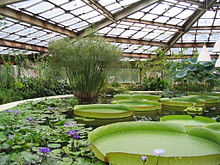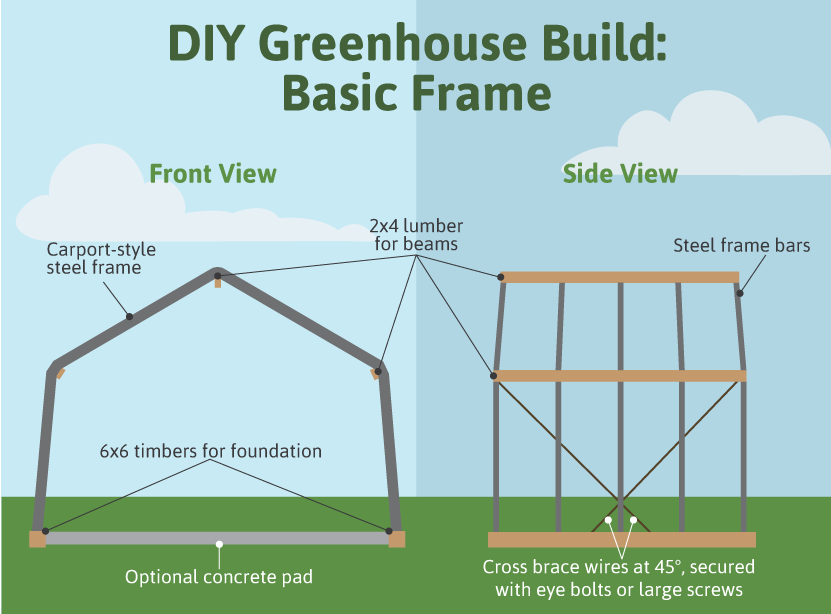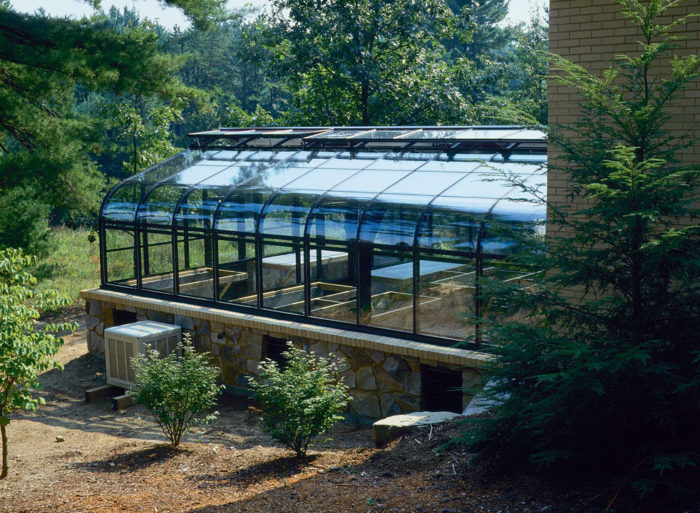6 Easy Facts About Greenhouse Construction Described
Wiki Article
About Greenhouse Construction
Table of ContentsGet This Report about Greenhouse ConstructionSome Known Factual Statements About Greenhouse Construction 9 Easy Facts About Greenhouse Construction ShownSome Of Greenhouse ConstructionThe Main Principles Of Greenhouse Construction

I hand dug a ditch four feet down to bedrock and built a concrete block wall from there to two feet above grade and filled all the cores with rebar and concrete. I also embedded threaded lag bolts in some of the block cores for securing the plates of the walls that would be built on top.
It took a lot of work but I was young and ambitious then. This foundation wall is under all three sides of the greenhouse addition. It isolates the earth inside, holds some heat, and keeps out frost and animals that like to dig tunnels. A lot of fragile glass is dependent on a solid, stable foundation.
While the foundation is being built is the best time to remove the old earth inside the greenhouse footprint and replace it. We had sand as fill around our house foundation when it was built. In the greenhouse footprint, we dug some of that away and left some for a base, then added Jen’s special soil mix on top.
The Single Strategy To Use For Greenhouse Construction

The sink has been very useful. A working greenhouse really needs an area with a sink, counter, and shelves. I don’t recommend burying wires in the greenhouse, but if you must, be sure they are protected inside some tough metal or plastic pipe. Greenhouse construction. Be sure to put a notice up on the wall with a map indicating where they are located

In the pictures and drawing you can see the three sections of our addition: the lower window wall resting on and bolted to the foundation wall, the slanted big windows making up most of the ceiling, and the roof that is attached to the house wall. The actual dimensions of your greenhouse will be custom designed for the materials, size, and area involved in your project, so my how-to advice is meant to give you ideas and methods to use rather than exact plans.
Rumored Buzz on Greenhouse Construction
It is expensive and there is so much excellent pre-owned glass available cheap or free for the taking that I look for that first - Greenhouse construction. I used some double-hung, double-glazed windows from my stash for most of the front window wall. They were installed on their sides with the screens in placeIt is a handy work platform while building and makes the exterior upkeep of that whole wall above it, and washing all those big windows, less complicated during the life of the house. The roof deck must be very sturdy. I framed it with 2x6s and decked it with ¾-inch plywood.
Like I said, build it sturdy. If you have been careful with your measuring and Discover More Here building and have not indulged in too much spontaneous construction, your lower window wall will be perfectly aligned horizontally and vertically with your roof deck so the rafters that connect them will all be exactly alike, fit perfectly, and accommodate the big windows to be installed on top of them.
I want to take a paragraph or two to let you in on a way to find the best glass ever for a greenhouse. The ones we used are 34″ x 75″ tempered glass. Of all the sizes of tempered glass available, that is the most common because it is used in sliding glass doors and those window walls you often see where people have a view, a deck, a swimming pool, or whatever, to gaze upon while sipping martinis.
A Biased View of Greenhouse Construction
Find him and make an offer on the old ones. I did this once and got 18 (count ’em x 2) fogged windows free just for hauling them away. You can find them at junk shops…excuse me, Architectural Antique Shops. Try the dump…or rather, Transfer Station. Ask around. I once found a supply of tempered glass this size at a mobile home supply store.Its Achilles Heel is the edge. If you tap the edge with metal the whole pane shatters to pieces. Be aware of this as you handle the glass. This is a broad view of the greenhouse during construction. Note the lower window official statement wall, stone wall, stop blocks, and window clamp boards and the roof deck which makes window washing easier.
I am going to show you a way to build these rafters differently than my originals. I woulda, coulda, shoulda done it this new way but you can learn from my experience. Plan the spacing between centerlines of the rafters. My glass was 34 inches wide. I want a 1-inch space between the panes.
Be very accurate about this 35-inch measurement as you build. Note: my knee braces under the roof deck line up with these rafters. Here is the difference between my old way and the new improved version. Way back then, I used single navigate to this website 2x6s as rafters. It worked, but not very well.
The smart Trick of Greenhouse Construction That Nobody is Discussing
I recommend you use doubled 2x6s or doubled 2x4s as rafters. That means the top of the rafters will be three inches wide and provide an ample supporting surface for the glass panes while leaving a one-inch space between them. You may think more is better and consider using larger sized rafters but don’t.Doubled 2x6s or doubled 2x4s are strong enough. Of course, use the best quality lumber for these rafters. Get good straight ones with few or no knots. Cutting the rafters to size takes good carpentry skills. There are angle cuts on each end and the dimensions have to be very accurate.
When you double up these rafters, make sure they are securely attached to each other with screws. In fact, use screws for attaching the rafters to the rest of the building too. Screws resist the push and pull of strains on the structure much better than nails, and if something needs changing or fixing later, screws are easier and neater to extract and reuse.
Before attaching the rafters, cut a piece of 90# rolled roofing 18 inches wide, and drape it over the whole length of the 2×8 top plate of the lower window wall. This covering will drain rainwater away on the outside and condensation away on the inside. This is an important detail.
Report this wiki page